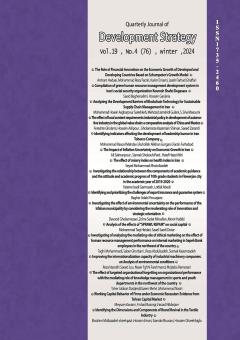-
-
List of Articles
-
Open Access Article
1 - The Role of Financial Innovation on the Economic Growth of Developed and Developing Countries Based on Schumpeter's Growth Model
Arsham Hodaei Mohamad Reza Farzin Karim emami jeze farhad ghaffari -
Open Access Article
2 - Compilation of green human resource management development system in Iran's social security organization
Koroush Shafeie Degesara saeed baghersalimi Hossein Ganji Nia -
Open Access Article
3 - Analyzing the Development Barriers of Blockchain Technology for Sustainable Supply Chain Management in Iran
Mohammad Hosein Asgharpour Sareshkeh Mehrzad Jamshidi Guilani S. Sina Masoumi -
Open Access Article
4 - The effect of local content requirements industrial policy in development of automotive industry in the global value chain: a comparative analysis of China and Mexico
Fereshte Gholami Hosein Aslipour Gholamreza Kazemian Saeed Zarandi -
Open Access Article
5 - Identifying indicators affecting the development of leadership humor in Iran Tobacco Company
mohamadrasol mahdavi Roholah Alikhan gorgani Farzin Farahbod -
Open Access Article
6 - The Impact of Inflation Uncertainty on Economic Growth in Iran
علی سلمانپور زنوز Siamak ShokouhiFard Hatef Hazeri Niri -
Open Access Article
7 - The effect of misery index on health index in Iran
seyyed mohammad mostolizadeh -
Open Access Article
8 - Investigating the relationship between the components of academic guidance and the attitude and academic progress of 10th grade students in Flowerjan city in the academic year of 2019-2020
Fateme Izadi garmaseh لطفعلی عابدی -
Open Access Article
9 - Identifying and prioritizing the challenges of export insurance and guarantee system
باقر ادبی فیروزجائی -
Open Access Article
10 - Investigating the effect of environmental uncertainty on the performance of the Isfahan municipality by considering the moderating role of innovation and strategic orientation
Davood Gholamrezaei zohre sadat mirsafian monir habibi -
Open Access Article
11 - Analysis of the effects of "SPRAWL REPAIR" on social capital
mohamad taghi heydari saadi saedi -
Open Access Article
12 - Investigating of analyzing the mediating role of ethical marketing on the effect of human resource management performance on internal marketing in Sepeh Bank employees in the northwest of the country
تقی محمدی saber ghorbani Reza abdollahzade siamak kazemzadeh -
Open Access Article
13 - Improving the internationalization capacity of industrial machinery companies: an Analysis of environmental conditions
Reza nasrolahi Saidello ناصر فقهی فرهمند مجتبی رمضانی -
Open Access Article
14 - The effect of targeted organizational forgetting on organizational performance with the mediating role of knowledge management in sports and youth departments in the northwest of the country
taher Jabbari Dastjerd Kazem Mehri mohammad nasiri -
Open Access Article
15 - Working Capital Behavior of Firms under Economic Recession: Evidence from Tehran Capital Market
میثم کاویانی فرشاد بزرگی nikfarjam farzad -
Open Access Article
16 - Identifying the Dimensions and Components of Brand Revival in the Textile Industry
Ebrahim mollazadeh shirehpazi Hossein emari siamak Mousavi Hossein Gharehbiglo
-
The rights to this website are owned by the Raimag Press Management System.
Copyright © 2017-2026







